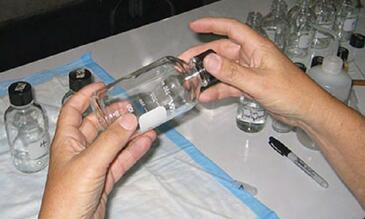
CDC Bottle assays were developed based on research performed in 1998. The CDC bottle bioassay determines if particular active ingredients are able to kill an insect vector, such as a mosquito, at a specific location at a given time. It can detect resistance to insecticides in mosquitoes and other insects. The technique is simple, rapid, and economical, compared with alternatives. The results can help guide the choice of insecticide used for spraying. It can also be used to determine LC50.
Bottle tests are performed on glass as this is the most ideal surface. Testing on different surfaces is performed after the results of the bottle assays are interpreted and the insecticide used is confirmed to be effective. The test is performed after topical testing and before surface testing to ensure that the insecticide works when applied on the most ideal surface.
CDC Guidance & Published Methods:
The test is based on these CDC guidelines
Bottle assays care used to determine effectiveness of insecticide and can also be used to determine time to kill. In LITE mosquitoes are used but the method can be adapted to test insecticide in other insect species. 250ml Wheaton bottles are used for bottle assays. These can be pre-coated by the client or coated in-house.
Related Publications:
- Brogdon, WG and McAllister JC, 1998. Simplification of adult mosquito bioassays through use of time-mortality determinations in glass bottles. J. Am. Mosq. Control Assoc. 14(2):159–64.
- National Center for Infectious Diseases, Centers for Disease Control and Prevention (CDC). Evaluating mosquitoes for insecticide resistance: Web-based instruction. Available from: http://www.cdc.gov/malaria.
- Zamora Perea E, Balta Leon R, Palomino Salcedo M, Brogdon W, Devine G, 2009. Adaptation and evaluation of the bottle assay for monitoring insecticide resistance in disease vector mosquitoes in the Peruvian Amazon. Malar. J. 8: 208
